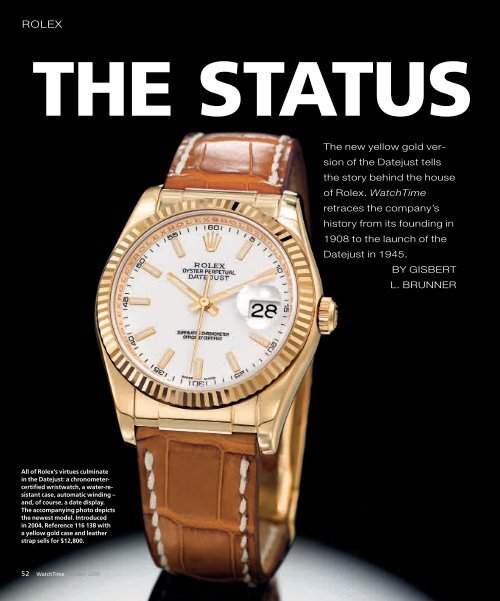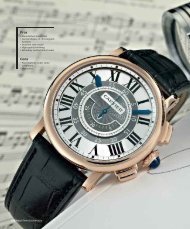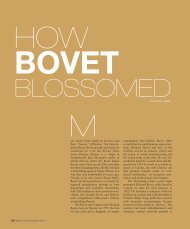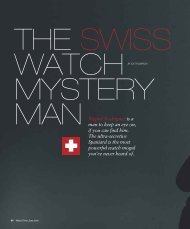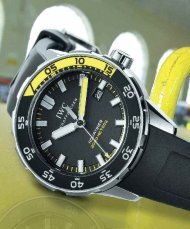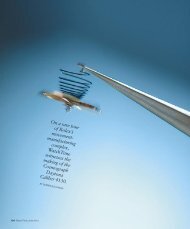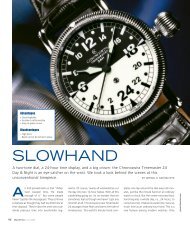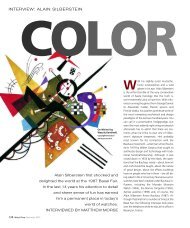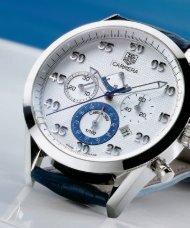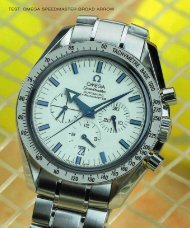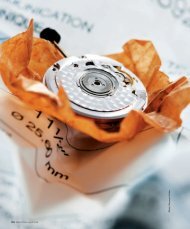WT_2004_05: ROLEX: THE STATUS SYMBOL
WT_2004_05: ROLEX: THE STATUS SYMBOL
WT_2004_05: ROLEX: THE STATUS SYMBOL
You also want an ePaper? Increase the reach of your titles
YUMPU automatically turns print PDFs into web optimized ePapers that Google loves.
<strong>ROLEX</strong><br />
<strong>THE</strong> <strong>STATUS</strong><br />
All of Rolex’s virtues culminate<br />
in the Datejust: a chronometercertified<br />
wristwatch, a water-resistant<br />
case, automatic winding –<br />
and, of course, a date display.<br />
The accompanying photo depicts<br />
the newest model. Introduced<br />
in <strong>2004</strong>, Reference 116 138 with<br />
a yellow gold case and leather<br />
strap sells for $12,800.<br />
52 WatchTime October <strong>2004</strong><br />
The new yellow gold version<br />
of the Datejust tells<br />
the story behind the house<br />
of Rolex. WatchTime<br />
retraces the company’s<br />
history from its founding in<br />
1908 to the launch of the<br />
Datejust in 1945.<br />
BY GISBERT<br />
L. BRUNNER
<strong>SYMBOL</strong><br />
The history of Rolex, like that of so<br />
many important global brands, began<br />
with an impressive entrepreneurial<br />
personality. Hans Wilsdorf left his native Germany<br />
at age 19 and went to Switzerland,<br />
where he got his first taste of the watch business.<br />
He moved on to London a few years later,<br />
where he found a business partner and<br />
started his own business. The company of<br />
Wilsdorf & Davis Ltd. conducted business at<br />
83 Hatton Gardens, where Wilsdorf laid the<br />
foundation for what would ultimately become<br />
a global watch empire.<br />
Wilsdorf was a skilful businessman with<br />
ambition and foresight. Soon after the turn of<br />
the 20th century, when most men wore pocket-watches<br />
and many people ridiculed the first<br />
timepieces for the wrist, he sensed that the future<br />
would in fact belong to the wristwatch.<br />
His business idea was a good one, but a critical<br />
ingredient was lacking. Wilsdorf hadn’t yet<br />
found a precise movement that could be encased<br />
inside a fashionable and adequately water-resistant<br />
case.<br />
This was the situation facing him when he<br />
moved his business to 44 Holborn Viaduct.<br />
The market square in Kulmbach, Germany. Wilsdorf’s<br />
grandfather’s shop can be seen in the center of the photo.<br />
Wilsdorf’s contacts with the Swiss watchmaking<br />
industry stood him in good stead now. He<br />
traveled to Biel and visited Aegler SA, a watch<br />
business that had developed an 11-ligne movement<br />
with a lever escapement and had already<br />
successfully encased that caliber inside its own<br />
wristwatches. Wilsdorf offered to distribute Aegler’s<br />
wristwatches in Great Britain, and the<br />
Swiss firm was amenable to the idea. By the end<br />
of his visit, the partners agreed on a first deal<br />
worth several hundred thousand Swiss francs.<br />
This was a daring step for Wilsdorf because the<br />
value of the deal was five times larger than the<br />
total operating capital of Wilsdorf & Davis Ltd.<br />
Fortunately, the reward for his courage was<br />
soon forthcoming. In 1913, Wilsdorf & Davis<br />
was granted exclusive rights to distribute Aegler<br />
wristwatches in Great Britain and throughout<br />
the British Empire.<br />
This trailblazing success didn’t materialize<br />
out of thin air. To simplify business dealings be-<br />
tween London and Switzerland, Wilsdorf had<br />
established an office in La Chaux-de-Fonds in<br />
1907. In 1912, when the collaboration with<br />
Aegler was already proceeding smoothly, Wilsdorf<br />
moved the office to Biel, where a managing<br />
agent ran things.<br />
Wilsdorf was too ambitious to accept the<br />
fact that the big English specialty shops like<br />
The Goldsmiths Company or Asprey insisted<br />
that their own name appear on the dials (and<br />
HANS WILSDORF WAS TOO AMBITIOUS TO LANGUISH<br />
IN ANONYMITY. HE WANTED TO MAKE A<br />
WATCH WITH HIS OWN BRAND NAME ON <strong>THE</strong> DIAL.<br />
sometimes even on the movements), forcing<br />
suppliers to languish in anonymity. With characteristic<br />
tenacity, he set out to put an end to<br />
this glory-hogging tradition. To accomplish his<br />
goal, however, he needed a brand name of his<br />
own and highly recognizable products.<br />
The beginning came in 1908 with the coining<br />
of the word “Rolex.” According to an unconfirmed<br />
legend, the neologism was born as<br />
an abbreviation of the French phrase “horlogerie<br />
exquise,” which means “exquisite ho-<br />
A view of Geneva and Quai Wilson, where<br />
Hans Wilsdorf lived during the 1950s.<br />
October <strong>2004</strong> WatchTime 53
<strong>ROLEX</strong><br />
rology.” Wilsdorf opted for the word “Rolex”<br />
because it could readily be pronounced in<br />
many different languages. Also, the two short,<br />
simple syllables required so little space on a<br />
watch’s dial that there was still plenty of room<br />
left to eternalize a jeweler’s name along with<br />
it. Wilsdorf’s next strategy was to make the Rolex<br />
name synonymous with quality and exclusivity.<br />
He asked his customers for permission to<br />
print “Rolex” on only a few of the watches<br />
that he supplied. After these pioneers had sold<br />
well, he gradually began increasing the number<br />
of “Rolex” watches in each package of six<br />
timepieces. Starting in 1925, he launched a series<br />
of uncommonly creative advertising campaigns<br />
in England. A further contribution to<br />
this successful strategy was made by the British<br />
Commonwealth and its world-traveling citizens,<br />
whose precise Rolex watches attracted<br />
admiring attention wherever they went. Nev-<br />
Rolex’s founder: Hans Wilsdorf<br />
The man who would go down in history as the<br />
founder of the world’s best-known brand of luxury<br />
watches was born in Kulmbach, Germany on<br />
March 22, 1881. Anna and Ferdinand Wilsdorf<br />
named their second child Hans Wilhelm. The talented<br />
boy enjoyed a sheltered childhood for the<br />
first twelve years of his life. But then his parents<br />
died unexpectedly, leaving uncles on his mother’s<br />
side of the family to care for the three orphaned<br />
Wilsdorf children. Hans was sent to a boarding<br />
school in Coburg, from which he graduated at the<br />
unusually young age of 17. He then went to business<br />
school in Bayreuth before turning his back on<br />
Germany at the turn of the 20th century. Wilsdorf’s<br />
late mother was a descendant of the wellknown<br />
Maisel brewing dynasty, so she had hoped<br />
her son would join the family business, but Hans<br />
had other plans. After a brief training with a pearl<br />
dealer in Geneva, he found a job that suited him at<br />
Cuna Korten in La Chaux-de-Fonds in 1900. This<br />
firm, which had its headquarters on posh Boulevard<br />
Léopold Robert, exported watches of all varieties.<br />
For a monthly salary of 80 francs, the multilingual<br />
newcomer took care of English correspondence<br />
and general office tasks. Among his daily<br />
chores was winding and monitoring the rates of<br />
several hundred watches. Korten, which generated<br />
an annual turnover in excess of one million<br />
francs, sparked Wilsdorf’s lifelong fascination with<br />
ticking timepieces. Korten purchased the greater<br />
portion of its merchandise from producers in Germany,<br />
France, and Switzerland. The ambitious<br />
young office assistant soon knew that his true calling<br />
was to go into business on his own. Wilsdorf<br />
54 WatchTime October <strong>2004</strong><br />
ertheless, 19 years would pass before Wilsdorf<br />
was able to deliver nothing but watches bearing<br />
his own insignia on their dials, movements,<br />
and cases. The final breakthrough came with<br />
the launch of the world’s first truly water-resistant<br />
wristwatch. Whether they liked it or not,<br />
dealers who wanted to sell this futuristic product<br />
now had no other choice but to accept the<br />
presence of the name “Rolex.” Wilsdorf had<br />
not only developed a genuinely practical wristwatch<br />
for daily use; he had also given the<br />
product a distinctive brand identity.<br />
More or less simultaneously with the start<br />
of the First World War, Wilsdorf and his partner<br />
in Biel agreed to change the name of the company.<br />
The firm that had formerly been known<br />
as “Les Fils de Jean Aelger – Fabrique Rebberg”<br />
was renamed “Rolex Watch Co., Aegler<br />
S.A., Manufacture d’Horlogerie, Usine du Rebberg.”<br />
Approximately 200 employees were<br />
commissioned three excellent<br />
watchmakers to<br />
each craft a golden chronometer-qualitypocketwatch.<br />
Neuchâtel Observatory<br />
duly awarded an<br />
official rate certificate to<br />
each watch. It didn’t<br />
take Wilsdorf long to sell all three pocket-watches<br />
for a tidy profit. Impressed, Wilsdorf’s bosses entrusted<br />
new tasks and greater responsibilities to<br />
their brilliant young employee, but the narrow horizons<br />
of the company were too confining for Wilsdorf.<br />
After a compulsory army stint in Germany, he<br />
again packed his bags and went to London. He arrived<br />
there in 1903 and founded his own business<br />
two years later.<br />
His beginning was hardly auspicious: Thieves had<br />
stolen his inheritance, which totaled 33,000 German<br />
gold marks, during a ship voyage, so he was<br />
obliged to borrow starting capital from his siblings<br />
and from a much older business partner named Alfred<br />
James Davis. Wilsdorf soon settled in and acquired<br />
British citizenship, a decision spurred on by a<br />
legal battle with the city of Geneva about the confiscation<br />
of a plot of land on the shore of Lac Léman.<br />
After the death of his first wife, May Florence,<br />
Wilsdorf married a native of Appenzell in 1950.<br />
During the winter months, the couple resided in<br />
their large, comfortable home at no. 39, Quai Wilson.<br />
The best ideas typically occurred to Wilsdorf<br />
during his morning ablutions, so the extremely well<br />
endowed gourmand and wine connoisseur usually<br />
spent up to two hours in the bath each morning.<br />
The cover of a brochure<br />
from the World War One era.<br />
occupied with the manufacture of Rolex<br />
watches. The enterprise conducted its business<br />
on the other side of the English Channel<br />
under the name “Wilsdorf & Davis, Rolex<br />
Watch Company.” This name was changed to<br />
This was where he conceived the famous magnifying<br />
(Cyclops) lens above the Oyster’s date display,<br />
which was originally intended to help his<br />
nearsighted wife read the date on her wristwatch.<br />
After breakfast, his trusty chauffeur Rüttimann<br />
would drive him to work in his Mercedes. Rolex’s<br />
boss had first put his trust in the German car<br />
brand around 1935. Rolls Royce repeatedly tried<br />
to convince Wilsdorf of the merits of their noble<br />
British brand, but had no luck in changing his<br />
mind.<br />
Wilsdorf’s employees appreciated the human<br />
side of their boss. At Christmas and before the<br />
beginning of the watchmakers’ annual vacation<br />
season, it was his habit to stroll through each department<br />
and shake each employee’s hand and<br />
personally thank them for their hard work. On<br />
Saturday mornings, Wilsdorf would occasionally<br />
invite a few friends to share a glass of port with<br />
him and listen to anecdotes about his far-flung<br />
journeys. In his later years, the firm’s founder was<br />
burdened by a limp but otherwise healthy. At his<br />
75th birthday celebration in 1956, one of the<br />
highlights of the evening was the presentation to<br />
Wilsdorf of a genuine world premiere: the Stick-<br />
O-Matic, a walking stick with a built-in self-winding<br />
watch.<br />
Twenty-one years after his death, Wilsdorf’s<br />
adopted hometown of Geneva honored him by<br />
naming a street after him. His native town of<br />
Kulmbach, Germany keeps his memory alive at<br />
Hans Wilsdorf Vocational School. His name, however,<br />
cannot rival that of “Rolex”, the brand that<br />
he invented and piloted to global renown.
Some early Rolex models. The one at the far left dates from 1915.<br />
“The Rolex Watch Company Ltd.” in November<br />
1915. More than 60 employees took care<br />
of worldwide sales here. They keenly felt the<br />
consequences of the war in 1919, when more<br />
or less overnight, the British government decided<br />
to impose a 33.3% duty fee on imports.<br />
Wilsdorf wasn’t very happy with Davis, so he<br />
bought out his partner’s share in the business.<br />
Wilsdorf and his wife moved to Geneva, and<br />
from this epicenter of luxury watchmaking,<br />
Wilsdorf planned to deliver his watches to a<br />
rapidly growing global market. The name<br />
“Montres Rolex S.A.” was registered on January<br />
17, 1920. The company’s sole proprietor<br />
and director explained the reasons for his decision<br />
to settle in the Rhône metropolis: “We settled<br />
in Geneva because we want to let our factory<br />
in Biel devote itself exclusively to the manufacture<br />
of watch movements, while we in<br />
Geneva concentrate on creating case models<br />
that suit the cultivated tastes of cosmopolitan<br />
Geneva. Components for Rolex movements<br />
will be made in Biel, but the calibers themselves<br />
will be assembled in Geneva, where they’ll be<br />
56 WatchTime October <strong>2004</strong><br />
The first chronometer<br />
tested in Kew<br />
subjected to the most meticulous testing.” Rolex’s<br />
familiar crown-shaped trademark was first<br />
officially registered in 1925. The five points on<br />
the crown represent the letters in the brand’s<br />
name and simultaneously symbolize the five<br />
fingers on a human hand.<br />
Business flourished steadily until September<br />
21, 1931, when the British pound was drastically<br />
devalued in the wake of the worldwide<br />
economic crisis. This devaluation had a dire effect<br />
on Rolex. Prices charged to customers<br />
throughout the Empire, which was still the<br />
company’s most important market, had to be<br />
adjusted upwards. Exports declined by more<br />
than 60%. If Rolex were to survive, the brand<br />
would have to acquire clientele not living under<br />
the Union Jack. Wilsdorf established subsidiaries<br />
in Paris, Buenos Aires, and Milan. He<br />
also commenced business activities in the Far<br />
East. The expansion paid off, as production of<br />
Oyster models gradually increased from 2,500<br />
to roughly 30,000 watches per year.<br />
Fate dealt Wilsdorf a harsh blow in 1944,<br />
just one year prior to the planned anniversary<br />
celebration, when his wife May Florence died<br />
unexpectedly. The couple had always spent<br />
the winters at Hotel des Bergues in Geneva,<br />
where they resided in a suite of rooms that was<br />
furnished with their own furniture and their<br />
own piano. In accord with his wife’s will, the<br />
childless Wilsdorf transferred his shares of<br />
Montres Rolex SA to the Hans Wilsdorf Foundation,<br />
thus ensuring that his business would<br />
outlive him. Establishing the foundation also<br />
entailed the hiring of two additional directors.<br />
This finally gave Wilsdorf free time for extended<br />
journeys to meet with customers in Africa,<br />
South America, and the U.S.A.<br />
The gigantic Rolex Festival, which lasted for<br />
several days in 1951, celebrated the 70th<br />
birthday of the beloved patron. It also commemorated<br />
his 50 years in the service of time<br />
measurement, the 25th anniversary of the<br />
Oyster case, and the 20th anniversary of the<br />
<strong>ROLEX</strong>’S BIG BREAKTHROUGH CAME WITH<br />
<strong>THE</strong> LAUNCH OF <strong>THE</strong> WORLD’S FIRST WATER-RESISTANT<br />
WRISTWATCH IN 1926.<br />
“Perpetual” rotor winding system. At this<br />
time, Rolex already had subsidiaries in Bombay,<br />
Brussels, Buenos Aires, Dublin, Havana, Johannesburg,<br />
London, Milan, Mexico City, New<br />
York, Paris, Sao Paulo and Toronto. Rolex provided<br />
workspace for some 400 employees in<br />
Geneva. Payrolls from the early 1960s list<br />
roughly 250 people on the staff in Biel.<br />
Wilsdorf didn’t live long enough to witness<br />
his firm’s unavoidable move into a new building<br />
on Rue François-Dussaud. This building,<br />
which is surrounded by a manmade watercourse,<br />
opened in 1965, roughly five years after<br />
Hans Wilsdorf passed away on July 6, 1960<br />
in Escale Fleurie, his summer home on the<br />
southern shore of Lake Geneva.<br />
Wilsdorf insisted that all Rolex movements<br />
be good enough to earn official rate certificates.<br />
No fewer than 48,347 of the 54,799<br />
certificates issued prior to 1944 were awarded<br />
to Rolex chronometers. The firm was awarded<br />
its 50,000th rate certificate in 1945, the same
<strong>ROLEX</strong><br />
year that Rolex celebrated its 40th anniversary.<br />
In a letter dated June 4, 1962, the watch-testing<br />
facilities confirmed that Rolex had already<br />
passed the magic number of 500,000 certificates.<br />
This was reason enough to now award<br />
the Red Seal, which had previously been given<br />
to all Rolex chronometers, only to specimens<br />
that had performed with “especially good results”<br />
in the official tests. As the years went by,<br />
the numbers continued to grow. Rolex cele-<br />
Rolex as a Foundation<br />
Wilsdorf transferred his shares of Montres Rolex<br />
SA to the Hans Wilsdorf Foundation in 1945.<br />
The foundation remains the owner of Rolex<br />
Geneva today. Wilsdorf even specified precise instructions<br />
for the distribution of dividends. A major<br />
portion of the money was to be donated to<br />
charity, a purpose that was fully in accord with the<br />
wishes of his deceased wife, who had frequently<br />
accompanied her husband to the office. Institutions<br />
in Geneva which benefit from Wilsdorf’s<br />
generosity include the school of watchmaking,<br />
the academy of fine arts, and the faculty for busi-<br />
58 WatchTime October <strong>2004</strong><br />
Rolex is the<br />
greatest pioneer in<br />
the testing of<br />
wristwatches for<br />
chronometer certification.<br />
The illustration<br />
shows rate<br />
certificates from<br />
1933 and 1965.<br />
brated its millionth chronometer in 1968, its<br />
two-millionth in 1973, and its ten-millionth officially<br />
certified chronometer in 1990. Rolex<br />
manufactured 814,720 of the 1,271,934<br />
movements tested by the C.O.S.C. in 2002.<br />
Although Rolex doesn’t release the exact statistics,<br />
it seems likely that the number of officially<br />
tested wristwatch chronometers with<br />
mechanical movements is slowly but surely<br />
nearing the 20-million mark – a unique record<br />
ness and social sciences at the university. The<br />
Swiss watch-research laboratory in Neuchâtel<br />
also receives Wilsdorf’s largesse. Donations from<br />
his foundation helped build a language library for<br />
the blind, a laboratory at the new school of<br />
watchmaking and an exhibition pavilion in<br />
Lucerne for the animal-protection league. The<br />
foundation also made available numerous radios<br />
and film projectors for charitable purposes. Finally,<br />
talented graduates from vocational schools in<br />
Geneva are eligible for awards and prizes from<br />
the foundation.<br />
that no other manufacture can even come<br />
close to challenging. The many records that<br />
Rolex has set in such tests prove what horological<br />
meticulousness can accomplish when applied<br />
to comparatively small wristwatch calibers.<br />
Nothing can take the place of wellthought-out<br />
construction, precise production,<br />
high-quality materials, and painstaking final<br />
quality-control checks.<br />
These wristwatches had to earn their enviably<br />
good reputation, not only for the accuracy<br />
of their rates, but also for their resistance to<br />
water. The edges of the crystal and the back of<br />
the case are critical locations, especially on a<br />
model with an angular case. The crown and its<br />
stem are also weak links in the water-resistance<br />
chain. Rolex was well aware of these<br />
facts. In the mid 1920s, at a time when wristwatches<br />
commanded only a 35% share of the<br />
market for portable timepieces, the young<br />
business set its sights on finding a once-andfor-all<br />
solution to the problem of leaky cases.<br />
Wilsdorf had first turned his attention to<br />
this crucial theme years before. An early step
<strong>ROLEX</strong><br />
PR for the first water-resistant wristwatch:<br />
swimmer Mercedes Gleitz…<br />
in the right direction had been the use of<br />
screw-in cases made by Dennison Watch<br />
Case. These cases are readily identifiable by<br />
the fluting on the rims of their crystals and<br />
backs. This channeling makes both components<br />
easy to grasp so that they can be<br />
screwed to the middle part of the case. This<br />
60 WatchTime October <strong>2004</strong><br />
…swam across the English Channel with an<br />
Oyster on her wrist.<br />
visible attribute continues to distinguish the<br />
backs of Rolex watches today.<br />
Wilsdorf relied on a purely mechanical construction<br />
without problematic materials. His formula<br />
for success can be summarized as follows:<br />
1. a hermetically sealed case, each part of<br />
which is screwed water-resistant;<br />
An early advertisement<br />
for the Rolex Oyster.<br />
The first<br />
Rolex Oyster<br />
from 1926.<br />
2. a new and perfectly form-fitting crystal<br />
made of synthetic material; and<br />
3. a crown that lastingly protects the movement<br />
against moisture penetration, even if the<br />
crown is operated daily.<br />
Wilsdorf purchased the rights to use an<br />
idea that had originally occurred to Georges<br />
Peret and Paul Perregaux. In October 1925,<br />
these two men became the first watchmakers<br />
to screw a crown onto a watch’s case. Rolex<br />
applied for a patent on a threaded case on<br />
September 21, 1926. Another application followed<br />
on October 18, this time for patent protection<br />
on a crown that was screwed to the<br />
middle part of the case. Corresponding<br />
patents were soon granted in Switzerland and<br />
Great Britain. There wasn’t much need for research<br />
because Rolex’s revolutionary inventions<br />
were entirely unprecedented. All that<br />
was missing was a catchy name to aptly express<br />
the characteristic attribute of the new<br />
case. After considering several possibilities, the<br />
name was chosen: “Oyster.”<br />
The first official appearance by the Oyster<br />
came soon thereafter. Mercedes Gleitze, a<br />
young stenographer from London, swam<br />
across the English Channel in the record-breaking<br />
time of just 15 hours and 15 minutes on October<br />
7, 1927. Afterwards, she showed her<br />
perfectly functioning Rolex to a crowd of astonished<br />
reporters. To publicize this sensational<br />
achievement, Wilsdorf ran a full-page ad on<br />
the front page of the Daily Mail. Although the<br />
ad cost Rolex a king’s ransom, more than 2 million<br />
readers saw the ad when the newspaper<br />
was published on November 24, 1927.<br />
Wilsdorf supplied his dealers with small,<br />
patented aquariums to display in their shop<br />
An Oyster model<br />
from 1928.
<strong>ROLEX</strong><br />
Healthy evolution: the first Datejust from 1945 (Ref. 4467, far left) combined all the Rolex virtues.<br />
Models from the 1970s are shown in the center and at the right.<br />
windows. Inside each aquarium, a ticking Oyster<br />
continued to show the correct time while a<br />
goldfish swam placidly all around it. Advertising<br />
campaigns featuring popular actresses and<br />
the Oyster’s participation in attention-getting<br />
pioneering airplane flights (where the watches<br />
successfully withstood severe temperature<br />
variations, extreme vibrations, and plenty of<br />
dust) further contributed to Rolex’s ever-growing<br />
renown.<br />
Despite patent protection, Rolex was soon<br />
obliged to defend itself against imitators. Legal<br />
proceedings were initiated in 1934 against the<br />
Schmitz Brothers case factory in Grenchen,<br />
Advertisement for the first Datejust.<br />
62 WatchTime October <strong>2004</strong><br />
Germany. After two-and-a-half -years of litigation,<br />
judges at a Swiss court unanimously<br />
agreed on July 8, 1937 that Schmitz Brothers<br />
owed compensatory damages to Rolex. The<br />
verdict made it clear that although Wilsdorf<br />
had not invented the concept of the water-resistant<br />
wristwatch, he was the first person to<br />
translate the idea into practical reality via industrial<br />
manufacturing methods. In this context, it<br />
became known that Rolex had invested 1.2 million<br />
Swiss francs in the launch and distribution<br />
of the Oyster case, thus formatively contributing<br />
to the growth of people’s confidence in water-resistant<br />
wristwatches and opening new<br />
markets for the entire watch industry. Roughly<br />
200,000 Swiss-made water-resistant wristwatches<br />
were sold in 1935-1936 alone.<br />
In 1926, Wilsdorf’s foresight had helped<br />
him identify another problem that beset wristwatches,<br />
one that still hadn’t been solved in<br />
the early 1930s. Of course, it was easy to hermetically<br />
reseal a crown once it had been<br />
pushed back in after winding the mainspring,<br />
but one instant of forgetfulness could render<br />
useless all of the hard work and ingenuity that<br />
Rolex had incorporated into a water-resistant<br />
wristwatch. What Rolex needed was a selfwinding<br />
movement that would eliminate the<br />
need for manual daily winding.<br />
Wilsdorf and his technical staff in Biel had<br />
defined the basic idea for a “Perpetual” in<br />
1930: “The invention of an automatic winding<br />
mechanism that moves back and forth silently,<br />
smoothly, and without a buffer.” This idea, of<br />
course, hadn’t materialized out of thin air.<br />
Wilsdorf described its background in his autobiography:<br />
“The logical consequence of the<br />
Rolex Oyster was the creation of an automatic<br />
watch whose movement would repeatedly<br />
wind itself on its own, thus ensuring that the<br />
timepiece would continue to run uninterruptedly.”<br />
The Rolex team based their research on<br />
the work of Abraham Louis Perrelet, Sr. (1729-<br />
1826), a self-taught watchmaker<br />
who had successfully experimented<br />
with a rotor in<br />
1770.<br />
The new Rolex Perpetual<br />
ticked satisfactorily in every respect in 1931.<br />
The advantages of the Perpetual didn’t<br />
lie solely in its rotating weight; the<br />
modular construction with a sepa-<br />
The Perpetual selfwinding<br />
model.<br />
Scarcely changed on the outside:<br />
a Datejust from 1988.
Rolex’s headquarters on Rue François-Dussaud in Geneva.<br />
rate group of components for the automatic<br />
winding mechanism can also be regarded as a<br />
trailblazing innovation. Modular architecture<br />
meant that it wasn’t necessary to disassemble<br />
the entire movement whenever the winding<br />
system required servicing. To guard against<br />
over-winding, a safety mechanism consisting<br />
of a slip-spring prevented the system from<br />
over-tightening and ultimately snapping the<br />
steel mainspring.<br />
Wilsdorf still had to market the new watch,<br />
and encountered many jewelers and watch<br />
merchants who still remembered their bad experiences<br />
with the Harwood; the first serially<br />
manufactured self-winding wristwatch. Fortunately<br />
for Wilsdorf, his was a much better<br />
<strong>2004</strong>: The Latest Models<br />
The new Datejust models<br />
for <strong>2004</strong> include (left)<br />
Ref. 116 238 in yellow<br />
gold ($17,250). Bigger<br />
hands distinguish the<br />
newcomers. The rehaut<br />
has also been updated:<br />
it’s now engraved with<br />
the brand’s name and (at<br />
the “6”) the individual<br />
case number. The same<br />
details apply for the<br />
Turn-O-Graph (right),<br />
Ref. 116 264 in stainless<br />
steel with rotating white<br />
gold bezel ($5,425).<br />
64 WatchTime October <strong>2004</strong><br />
watch in every respect, and eventually the Perpetual’s<br />
inherent excellence, coupled with<br />
well-targeted advertising campaigns, overcame<br />
any hesitations.<br />
The 15 years of the original patent protection<br />
came to an end in 1948, but Rolex still<br />
held a commanding lead over nearly all its<br />
competitors. After all, for the past decade and<br />
a half, rotor winding and other refinements in<br />
Rolex’s Perpetual had been off limits to them.<br />
Only after 1948 were competitors permitted<br />
to introduce their own systems. Rolex wanted<br />
to debut a date display watch to mark the<br />
firm’s 40th birthday in 1945. The Datejust (caliber<br />
740) was a world’s first, becoming an archetype<br />
that would influence the technology<br />
Four decades of continuity: André J. Heiniger<br />
(1921-2000) led Rolex from 1963 to 1992,<br />
when his son Patrick Heiniger took the reins.<br />
and appearance of generations of subsequent<br />
watches. The watch’s name was carefully selected:<br />
“Date” is self-explanatory, while “Just”<br />
stands for “just in time.” And this means that<br />
the date display advances to show the next<br />
day’s date without delay at midnight. The<br />
watch was the world’s first fully water-resistant<br />
men’s wristwatch with automatic rotor winding,<br />
central seconds, and window-type date<br />
display whose accurate rate was verified by an<br />
official chronometer certificate.<br />
The Datejust featured a central secondshand<br />
and a readily legible date display inside a<br />
window at the “3,” a location chosen for a<br />
very good reason: most people wear a wristwatch<br />
on their left wrist, so the date display at<br />
the “3” is the first indicator that comes into<br />
view when the timepiece peeks out from under<br />
your shirt cuff.<br />
WatchTime would like to thank Wempe<br />
Jewelers for granting us permission to<br />
reprint portions of Gisbert L. Brunner’s upcoming<br />
book on Rolex.


